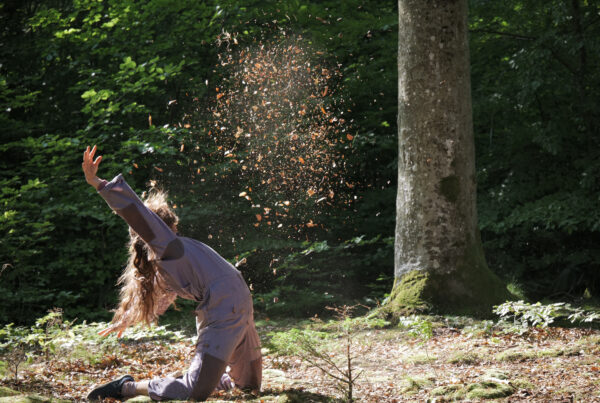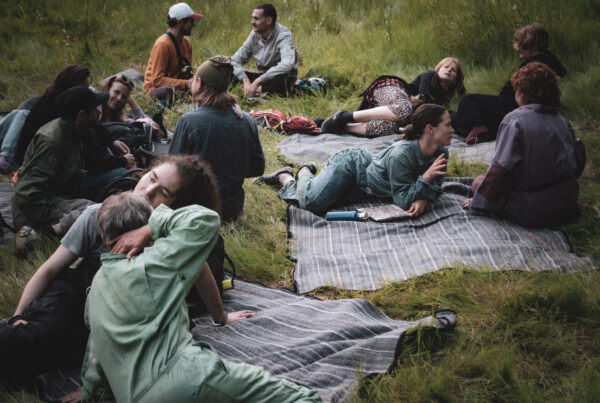author: Lightsey Darst
source: www.mnartists.org
date: February 03, 2007
1.The figure, brightly lit, moves in a flurry. The sound is like a CD skipping. Arms, more than making sense, flicker through space, straight, bent, high, low, close to the body or widely sweeping. Some of the arms, thin and wooden, belong to a mannequin breastplate the figure wears; human arms manipulate jointed puppet arms too rapidly to be really seen. Other than the arms, nothing moves. An impassive head seems unrelated to the winging arms; the mannequin breastplate conceals any natural movement of the torso. The watcher feels nervous: the half-human mover is like something from Metropolis, its speed and discontinuity vaguely threatening. Then the image slows. The flickering series of images goes on, but often the screen flickers between two frames, or two sequences, rather than skipping pell-mell onward. The sweeps of the arms can be seen now, the human arms manipulating the puppet arms; the flickering becomes a halo the viewer sees the figure through. It’s hard now not to see the gold-toned figure with its wing-like arms as angelic. The music also coheres. It’s as if something beyond our comprehension has been slowed for us: we see into another way of seeing, into a god-like perspective that can hold two moments at once in consideration. What is sacred is the movement—the movement, meaningless, not gestural, cutting through space and its afterimage following it. The viewer is aware of distance and of the usually invisible perceptual limits. What your eyes see always is something created, something already not real by the time you have seen it; the dancer has moved infinitesimally between the time the light left his body and the time it reached your eyes. Il S’agit, directed by Antonin De Bemels, frees human vision from its usual place in time and space.
2. Kino Friday, February 16, the Rogue Buddha Gallery will host Kinesthetic Kino, an international collection of dance films curated by Olive Bieringa of BodyCartography. This Friday’s presentation echoes a December presentation of some of the same material, in the same space. In December, in three film segments and a panel discussion, Bieringa presented enough dance film and information on dance film to make any novice feel educated about the genre, its possibilities, and its critical interest. Perhaps the most surprising discovery is that dance film is quite a broad category. A division proposed at the recent Screendance convention at last year’s American Dance Festival (and reported on in this article by Karen Pearlman:) is useful: dance on screen, which is generally dance made for the stage transferred to the screen; video dance, which emphasizes filmic thinking; and dance film, a crossbreed of the other two. Filmed dance (or screendance, or whatever its group name), then, includes everything from Maya Deren to performance videos to the film version of West Side Story. Because dance film generally fits in the avant garde wing of the dance world, which has long held that pedestrian movement can be dance, practitioners often include Charlie Chaplin and Buster Keaton films (among others) in the dance film category. Finally, dance film doesn’t always include actual human bodies; film of inanimate objects can be edited with a dance sensibility. Some might be inclined to challenge all this. Where does dance film end? Can I view every film as if it were dance? However, the answer—a slow yes—doesn’t solve anything, and disputing boundaries is ultimately not nearly as interesting as bringing back some insights from the far-flung edges of this fairly recently named but already broad-based art form.
3. “Power and immortality” “I think I was drawn to the form,” choreographer Wendy Morris said in the December panel discussion, “because I wanted power and immortality.” Dance film can relay and preserve dance performances, by their nature local and ephemeral. Because more and more dancers are getting behind cameras (instead of leaving the work to camera professionals who know little about what they are filming, as in the past), today’s dances on screen show far more clearly the qualities of specific dancers and dances than, for example, your daughter’s recital videos. This filmic immortality, incidentally, challenges the longstanding and not always cordial relationship between dance and dance writing. This may explain in part why critics have been so slow to expand their dance beats to include dance films: they’re not keen to assist at the ceremonies celebrating their own obsolescence. The dancers, through screen dance, have become their own historians. Film’s flexibility also grants power to the director-choreographer. Suddenly tiny gestures, nuances that wouldn’t read from even the second row of a theater, are useful; the dancer’s face is also more available. Editing concentrates the best moments: dancers can leap without coming down, improvisers can use their two minutes of brilliance and discard their eight minutes of futzing, the camera can catch the dancer at the moment when her hair spreads out in front of her as if leading her on. Having summarized dance film’s draw, though, Morris then ruefully added that she didn’t think it had given her either power or immortality. It’s not that she found dance film unrewarding, rather that she discovered that it’s simply different from live dance, not easier, better, or more definitive. Some dancers in the audience at the panel discussion seemed nervous about the whole idea of film. Dance’s immediacy, its moment of communion, is lost, they said; the camera’s mechanism interferes between the eye and the dance; the eternity of film is contrary to the presence of dance. The dancers were especially anxious about the idea of the dance being permanently accessible, and always in the same form. Dancers and choreographers, unlike many other types of artists, don’t get to noodle with their creations endlessly. They have a performance run, they perform, and that’s it, it’s over (until the next run). Part of the art of dance lies in that making do with the moment—with the injury, the lack of sleep, the missed lift, the small audience, with whatever other contingency arises. What the disputes point out is the need for specialized training for those appearing in dance film. Olive Bieringa, who’s been in and co-directed many dance films, talked about being aware of the camera’s lens and of how her limbs were moving into and out of its frame. The evening’s showing proved that dance film works best when the dancers are photogenic, when they’re able to create interest with their faces as well as their bodies. But back to that power and immortality for a moment. There’s no doubt that dance film does promise a certain kind of power to audiences and dancers: the power to see and be seen by anyone, anywhere, anytime. Audiences don’t have to fly to Europe to see current continental trends; they don’t have to fly back in time to see Nureyev. They don’t have to crawl into small corners to see site specific work or pay high prices to see great ballet companies. Dance film sets dance free from space and time constraints.
4. Flaws/pleasures I haven’t loved all the dance film I’ve seen. Some work feels like dance tourism (look at me dancing here! and dancing here! and dancing here!); some work veers dangerously close to freak collection (isn’t it great how strange this guy is?). Sometimes the focus on nuance is taken too far; not all subtle movements are worth watching. Sometimes film’s exactness removes the imaginative work that one enjoys doing in the theater—imagining a setting, imagining how the dancer looks up close. But for every work suffering from one of these flaws, there’s a work exploiting the flip-side of the flaw. For me, dance film at its best evokes the pleasure of seeing the tiny, the hidden, the momentary. It reminds me of the visual installations of Charles Matson Lume, in which fragile effects of light are coaxed into notice. You see, and feel privileged to have seen.
5. Why “dance” film? If this category includes Maya Deren and Buster Keaton, someone is bound to ask, why isn’t it just film? Why is dance claiming it? Two answers: first, because dance is singularly open right now. Dance was never firmly modernist or postmodern (revisit Martha Graham and you’ll find her “modern” dance quite expressive, even romantic), so unlike some other art forms, it’s not struggling out from under the weight of a heavily theorized past. Where visual art is futzing with the idea of the end of art and the literary arts are baulking at the edge of recent discoveries about the nature of meaning, in dance it is in some sense possible to simply Start Here. This is a tremendous generalization, of course, but a good case can be made for dance as the art form most open to new ideas. The second answer is related to the first. Dance is, right now, the buzzing hive of a whole set of thoughts about embodiment, the body-mind connection, the physical nature of lived experience, and so on. I admit I don’t know much about these ideas; by their very nature they are not entirely mentally knowable. Olive Bieringa is surely an expert in them, running simultaneously as she is in the channels of dance film, site specific work, and Body-Mind Centering. Ask her if you want further details. I can tell you that these ideas are anti-narrative, anti-traditional ideas of meaning, anti hierarchy, and anti-meaninglessness. They are some of the most hopeful ideas out there, and they are at the root of a lot of these films, which explore the life of the embodied.
6. A few films: Snaps and flashes Gold: breakneck preteen gymnasts tumble and pose. Fisticuffs: in the perfect bar fight, no one gets hurt, but everything gets broken. Have You Started Dancing Yet?: dancers talk cheekily about dance. Collateral Damage: GI Joe does contact improv. The Cost of Living, a somewhat longer film about British misfits in a misfit town, deserves more space; it’s a sort of modern musical, engaging, moving, and funny. All the above screen at 7 (with a few more); Pierre Coulibeuf’s Somewhere in Between, a long exploration/parody of expatriate American choreographer Meg Stuart’s work (the parody coming from Stuart herself, of course), screens at 9. Altogether, Bieringa’s put together a lively, varied, and entertaining evening. If you are remotely interested in dance film, you should go. If you miss it, though, don’t despair: I’ve noticed that dance film events crop up with ever-increasing frequency. Look for the Capture series, every three months or so at the Bryant-Lake-Bowl; watch the Walker schedule. Dance film is a growing field. It’s time we paid attention.


